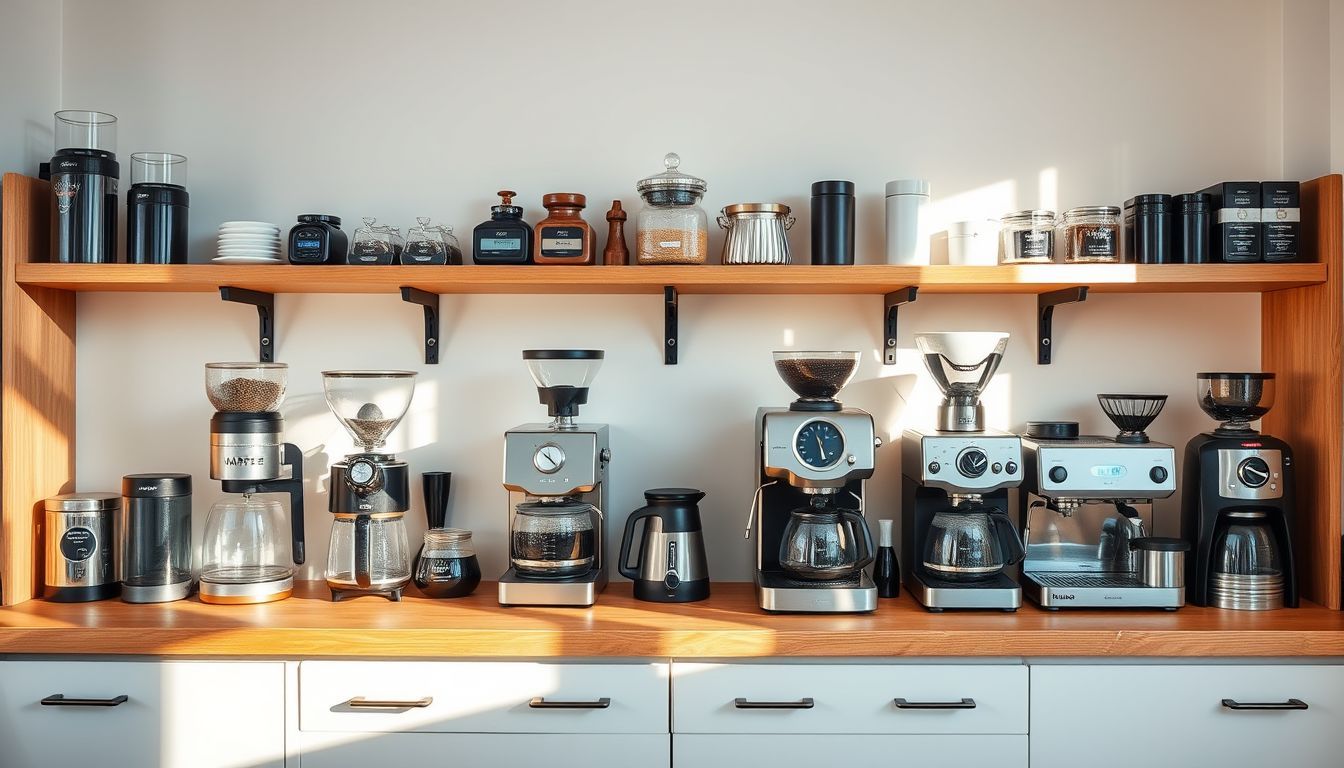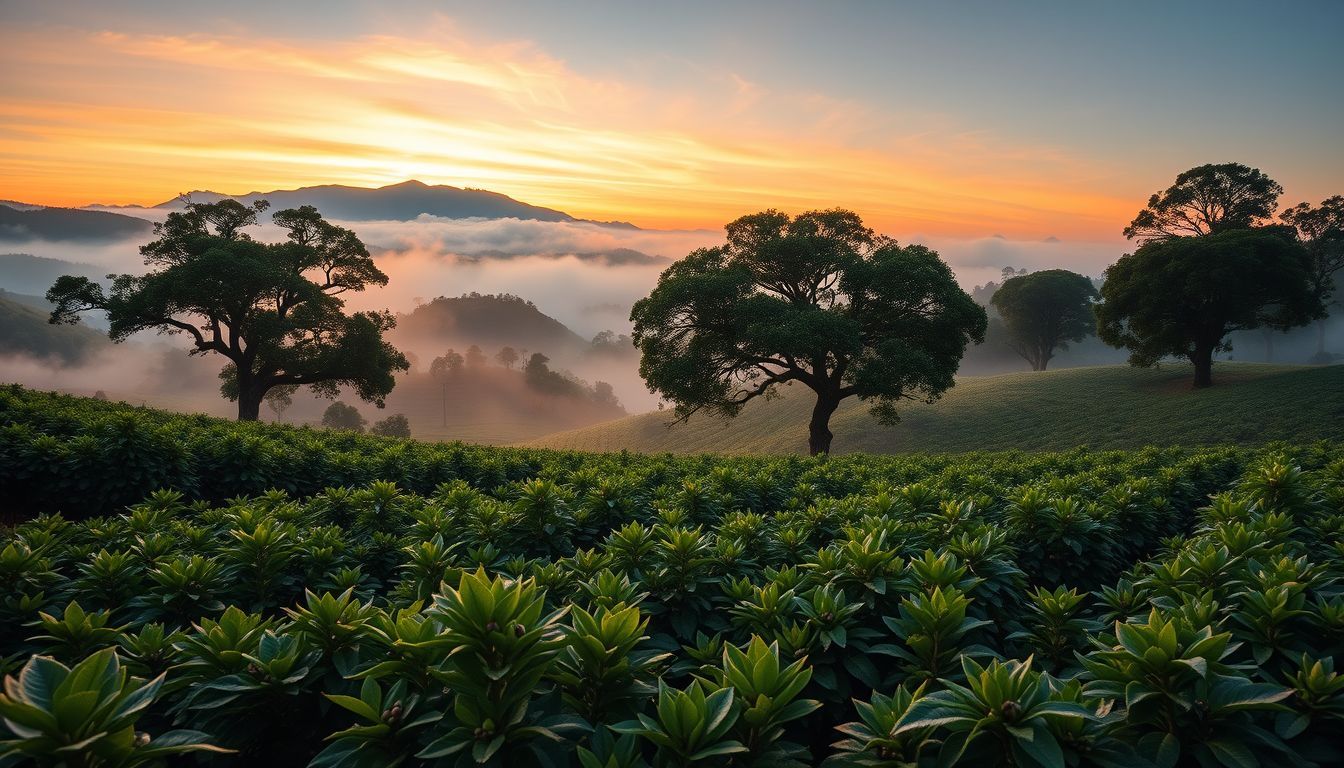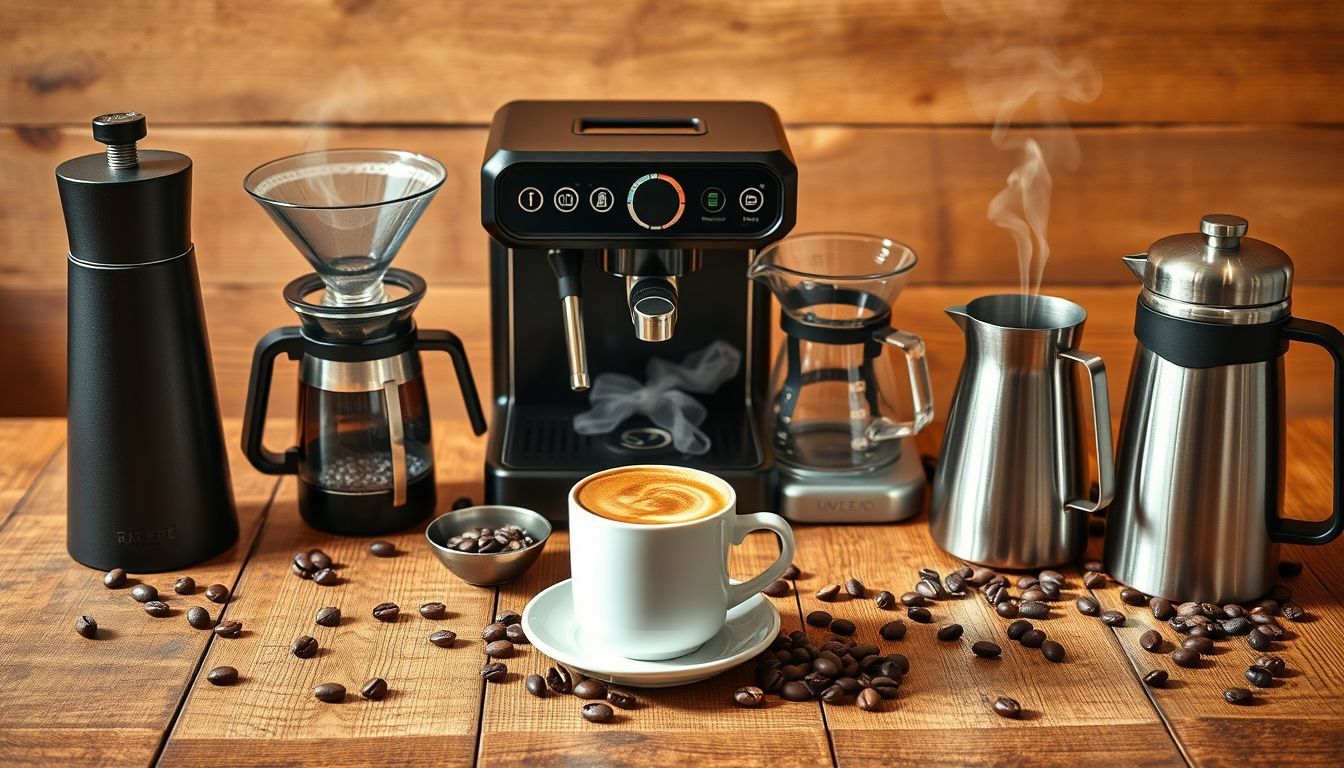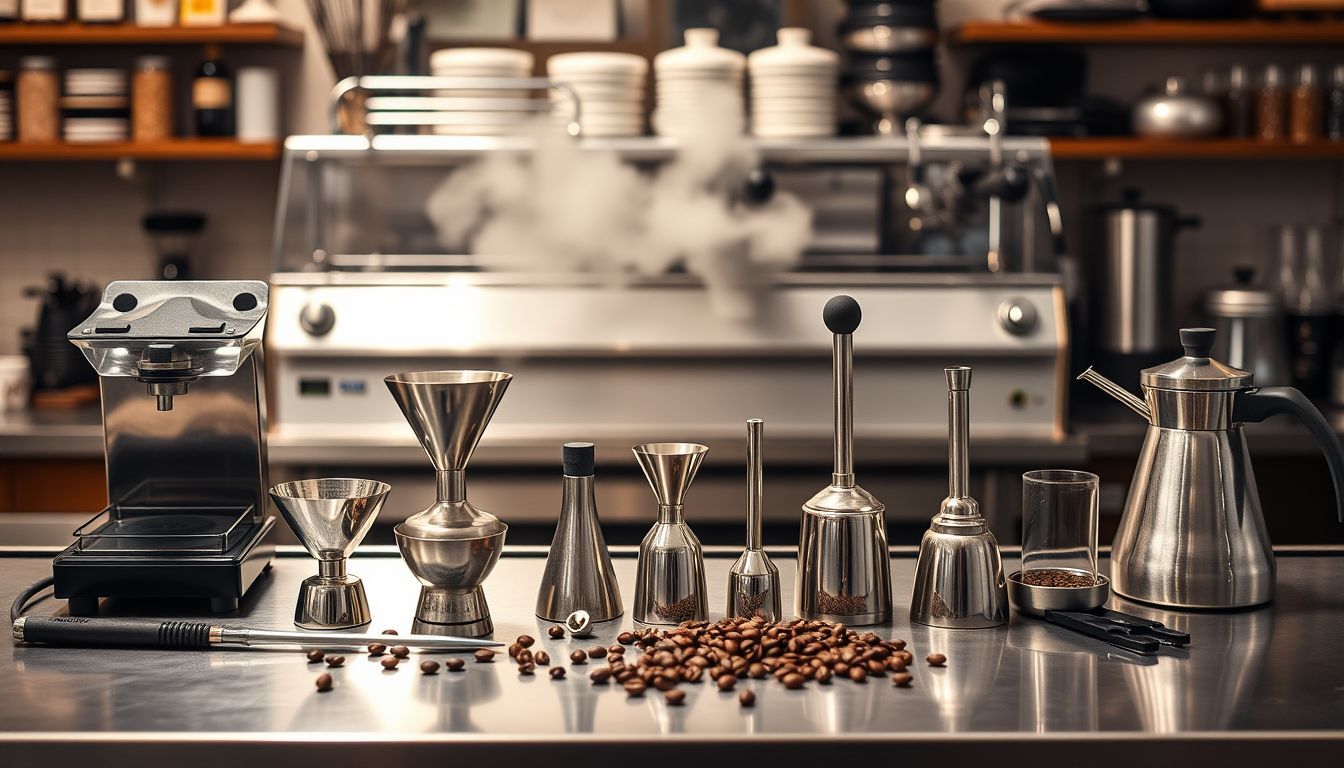The Ultimate Coffee Station Setup on Any Budget
Build your dream coffee station without breaking the bank. From $100 starter setups to $5000 enthusiast dreams, discover how to maximize your coffee game at every price point with strategic equipment choices and smart upgrades.

Amazon Affiliate Disclosure
This post contains affiliate links. If you purchase through these links, we may earn a small commission at no additional cost to you.
The Ultimate Coffee Station Setup on Any Budget
Let me guess: you've been scrolling through Instagram, admiring those pristine coffee stations with their gleaming espresso machines, perfectly organized accessories, and lighting that would make a photographer weep with envy. Then you look at your sad corner with a drip machine from 2003 and wonder if achieving coffee nirvana requires selling a kidney.
As someone who's analyzed coffee equipment markets for fifteen years and witnessed everything from $50 miracles to $15,000 monuments to caffeine obsession, I'm here with good news: exceptional coffee doesn't require exceptional budgets. What it requires is strategic thinking, smart prioritization, and understanding that the most expensive equipment isn't always the most effective.
Today, I'm breaking down how to build the ultimate coffee station at every budget level—from college dorm room constraints to "money is no object" fantasies. Because everyone deserves great coffee, regardless of their bank account balance.
The Philosophy of Strategic Coffee Investment
Quality Over Quantity, Always
Before we dive into specific budget tiers, let's establish the fundamental principle that separates successful coffee setups from expensive disappointments: it's better to have one excellent piece of equipment than five mediocre ones.
This isn't just coffee snobbery—it's practical economics. A $200 manual grinder will serve you better than a $200 espresso machine, $200 automatic brewer, and $200 milk frother combined. Focus your budget on the equipment that has the greatest impact on your daily coffee experience.
The Coffee Station Hierarchy
After analyzing thousands of home setups, I've identified the priority order for coffee station investments:
- Grinder – The foundation of everything
- Brewing method – Your daily driver
- Scale – Consistency enabler
- Water quality – The overlooked game-changer
- Storage – Freshness protector
- Accessories – Convenience enhancers
This hierarchy remains consistent across all budget levels—only the specific equipment choices change.
Budget Tier 1: The Starter Setup ($100–$300)
The Minimalist’s Dream
Don't let the modest budget fool you—this tier can produce coffee that rivals expensive café drinks. The key is focusing on fundamentals and avoiding the temptation to spread your budget too thin.
Essential Equipment
Grinder: Timemore Chestnut C2 manual grinder
For just under $70, the Timemore Chestnut C2 manual grinder punches way above its weight class, delivering grind consistency that embarrasses electric grinders costing three times as much. Yes, it requires manual effort, but we're talking about 30 seconds of cranking for exceptional results.
Brewing Method: Hario V60 + Filters
The Swiss Army knife of pour-over coffee, the Hario V60 Ceramic Coffee Dripper, Size 02 offers superb control over extraction and flavor clarity. Pair it with quality paper filters, and you’ll be amazed at how bright this setup can brew.
Scale: Basic Digital Kitchen Scale ($15)
Consistency is more important than precision at this level. Any scale that measures to the gram will dramatically improve your coffee compared to eyeballing measurements.
Water: Brita Filter ($30)
If your tap water tastes bad, your coffee will taste bad. A simple carbon filter eliminates chlorine and improves taste significantly.
Storage: Airtight Container ($20)
Protect your beans from air, light, and moisture. A simple airtight container preserves freshness better than leaving beans in their original bags.
Kettle: Stovetop Gooseneck ($25)
Pour control is crucial for V60 brewing. A basic stovetop gooseneck kettle provides the control you need without electric complexity.
Total Investment: $195
The Strategy
This setup prioritizes the fundamentals: consistent grinding, controlled brewing, and basic measurement. Every component serves a specific purpose, and there's no redundancy or unnecessary complexity.
Upgrade Path
When ready to expand, prioritize a better scale with timer functionality, then consider adding an AeroPress for brewing variety.
Budget Tier 2: The Enthusiast Setup ($300–$800)
Stepping Up the Game
This budget allows for significant quality improvements and the addition of convenience features that make daily coffee preparation more enjoyable.
Essential Equipment
Grinder: 1Zpresso JX-Pro
This manual grinder delivers near-commercial quality grinding with exceptional build quality and precision adjustment capabilities. For enthusiasts seeking both versatility and durability, the 1Zpresso JX-Pro manual grinder handles everything from espresso to French press with ease.
Primary Brewing: Chemex 6-Cup
The Chemex produces clean, bright coffee and serves multiple people—perfect for households or entertaining. The Chemex Classic Series 6-Cup Pour-Over Glass Coffeemaker combines iconic design with performance, and proprietary thick bonded filters further enhance clarity.
Secondary Brewing: AeroPress ($40) + Filters ($10)
Adding brewing variety keeps coffee interesting. The AeroPress excels at concentrated coffee and offers completely different flavor profiles from the Chemex.
Scale: Hario V60 Drip Scale ($60)
Built-in timer and better precision improve consistency and technique development.
Kettle: Fellow Stagg EKG ($165)
Precise temperature control and excellent pour characteristics make this an enthusiast favorite.
Water: Third Wave Water Packets ($25)
Optimal mineral content for coffee extraction represents a significant step up from basic filtration.
Storage: Fellow Atmos Vacuum Canister ($35)
Vacuum-sealed storage significantly extends bean freshness compared to basic airtight containers.
Accessories: Decent Tamper ($30) + Cleaning Supplies ($20)
Proper maintenance tools and basic accessories for optimal performance.
Total Investment: $604
The Strategy
This tier introduces precision and convenience while maintaining the manual, hands-on approach that builds coffee knowledge. The dual brewing methods provide variety and allow for different coffee styles.
Upgrade Path
Consider adding a precision refractometer for extraction measurement, or begin exploring espresso with a manual machine like the Flair.
Budget Tier 3: The Prosumer Setup ($800–$2,000)
Serious Coffee Business
This budget enables semi-professional equipment that can handle high volume while delivering café-quality results consistently.
Essential Equipment
Grinder: Comandante C40 with Red Clix
When only the best will do, the Comandante C40 MKIII Nitro Blade Grinder offers micro-adjustment capabilities and build quality that will last decades.
Espresso: Flair Pro 2 ($350)
Manual espresso that rivals machines costing thousands. Requires technique but delivers uncompromising quality.
Filter Brewing: Chemex + V60 Setup ($80)
Multiple brewing options for different coffee styles and occasions.
Scale: Acaia Pearl ($140)
Professional-grade precision with app connectivity and advanced timing features.
Kettle: Fellow Stagg EKG ($165)
Precise temperature control remains crucial at this level.
Water: Whole House Filter System ($300)
Optimal water quality for all coffee preparation and general household use.
Storage: Multiple Fellow Atmos Canisters ($140)
Separate storage for different coffee types and roast levels.
Accessories: Professional Tool Kit ($200)
Tampers, distribution tools, cleaning supplies, and measurement tools for optimal technique.
Coffee: Monthly Specialty Subscription ($50/month)
Access to exceptional beans that showcase equipment capabilities.
Total Investment: $1,705 (plus ongoing coffee costs)
The Strategy
This tier focuses on precision, consistency, and the ability to explore advanced techniques. The manual espresso capability opens up an entirely new dimension of coffee preparation.
Upgrade Path
Consider adding a quality electric grinder for convenience, or explore home roasting with an entry-level roaster.
Budget Tier 4: The Dream Setup ($2,000–$5,000)
No Compromises
This budget eliminates most practical constraints and allows for equipment that prioritizes performance and convenience equally.
Essential Equipment
Primary Grinder: Niche Zero ($650)
Single-dose electric grinding with exceptional consistency and minimal retention.
Secondary Grinder: Comandante C40 ($280)
Maintaining manual grinding capability for travel and backup.
Espresso: Decent Espresso DE1+ ($3,500)
For the ultimate in home espresso, the Decent Espresso DE1+ espresso machine delivers professional-grade pressure profiling, temperature control, and data logging capabilities.
Filter Brewing: Complete Pour-Over Station ($300)
Multiple brewing devices, premium filters, and specialized accessories.
Scale: Acaia Lunar ($200)
Espresso-specific scale with advanced features and compact design.
Water: Professional Filtration System ($500)
Commercial-grade water treatment for optimal extraction.
Storage: Climate-Controlled Coffee Cabinet ($400)
Precise environmental control for bean storage.
Accessories: Complete Professional Kit ($300)
Every tool needed for advanced coffee preparation and maintenance.
Total Investment: $6,130
The Strategy
This tier eliminates compromise and provides professional-grade capabilities in a home environment. The focus shifts from budget optimization to performance maximization.
The Universal Principles
Regardless of Budget
Certain principles apply across all budget tiers:
Fresh, Quality Beans: No equipment can compensate for stale or low-quality coffee. Allocate 10–15% of your coffee budget to beans.
Proper Technique: The most expensive equipment is worthless without proper technique. Invest time in learning and practicing.
Maintenance: Regular cleaning and maintenance preserve equipment performance and longevity.
Water Quality: Often overlooked but critically important. Address water quality at every budget level.
The Upgrade Strategy
Successful coffee station evolution follows predictable patterns:
- Start with fundamentals – grinder and basic brewing
- Add precision – better scales and temperature control
- Expand variety – additional brewing methods
- Increase convenience – electric grinders and automated features
- Pursue perfection – professional-grade equipment and advanced techniques
Common Mistakes to Avoid
The Espresso Trap
Many beginners assume they need espresso capability immediately. Quality espresso requires significant investment in both equipment and technique. Master filter brewing first—it's more forgiving and less expensive.
The Gadget Accumulation
Avoid collecting coffee gadgets without clear purpose. Every piece of equipment should serve a specific function in your coffee routine.
The Brand Obsession
Expensive brands don't always equal better performance. Focus on functionality and reviews rather than marketing and aesthetics.
The All-or-Nothing Mentality
You don't need to build your ultimate setup immediately. Gradual upgrades allow you to learn and appreciate each improvement.
Space Considerations
Small Space Solutions
Limited space doesn't mean limited coffee quality:
- Vertical storage maximizes counter space
- Multi-purpose equipment reduces clutter
- Wall-mounted accessories free up counter space
- Compact brewing methods like AeroPress excel in small spaces
Large Space Opportunities
Ample space allows for:
- Dedicated coffee zones with proper workflow
- Multiple brewing stations for different coffee styles
- Storage solutions that preserve bean quality
- Display areas that showcase equipment aesthetically
The Psychology of Coffee Station Design
Creating Ritual
A well-designed coffee station encourages consistent use and technique development. The physical arrangement should support your brewing workflow and make the process enjoyable rather than burdensome.
Visual Appeal
While function trumps form, aesthetic appeal increases daily satisfaction and pride in your setup. Choose equipment that you enjoy looking at and using.
Accessibility
Frequently used items should be easily accessible, while occasional-use equipment can be stored separately. Design your station around your actual usage patterns, not idealized scenarios.
Conclusion: Your Coffee Journey Starts Here
After analyzing countless coffee setups across every budget range, I've learned that the best coffee station isn't the most expensive one—it's the one that matches your needs, space, and commitment level while delivering consistent results you genuinely enjoy.
The beauty of building a coffee station lies not in reaching some predetermined endpoint, but in the journey of continuous improvement and learning. Each upgrade teaches you something new about coffee, and each brewing session offers an opportunity to refine your technique.
Whether you're starting with a $100 budget or planning a $5,000 investment, the principles remain the same: prioritize quality over quantity, focus on fundamentals before pursuing complexity, and remember that the best equipment is the equipment you'll actually use consistently.
Your perfect coffee station is the one that makes you excited to wake up each morning, that fits seamlessly into your routine, and that produces coffee you genuinely love drinking. It might be a simple V60 setup on a dorm room desk or a professional-grade espresso station in a dedicated coffee room—what matters is that it serves your needs and brings you joy.
So start where you are, with what you have, and begin building. Your coffee journey is uniquely yours, and every step forward is progress worth celebrating. The perfect cup is waiting, and it's closer than you think—regardless of your budget.
Now stop scrolling through those Instagram coffee stations and start building your own. Your future caffeinated self will thank you, one perfectly brewed cup at a time.

Sofia Rossi
I started my career in a world of spreadsheets and boardrooms, but I quickly realized the most interesting data was in the way people interacted when the pressure was on. My novels are my way of analyzing the human heart—the messy, complicated, and often hilarious parts. I write about the lives we lead now, with all the love, ambition, and absurdity that comes with it.


